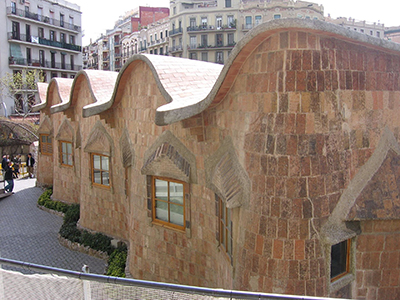Gaudi was a Barcelona based architect who was in-charge of Sagrada Familia (1883), whereby he changed the design to his nature-based organic style since construction had already begun. He also experimented with various presentations of ancient techniques such as the Casa Calvet, Casa de Los Botines, Episcopal Palace and Art Nouveau.
What was his role in the Design and build of this Development?
Gaudi changed the design of the church from the Gothic style as he felt it didn't get influenced by nature. He believed God's house should not necessarily have extensive supports that were used in the Gothic structures. The support structures mimic's stems of plants, twisted iron sculptures, curved rounded stone construction, frequently avoiding straight lines, and used lots of ceramic mosaics. His design was unique as it allowed enough natural light to penetrate the church and was still stronger and lighter.
Techniques, Planning, and Materials Involved
The highest point at the structure has an attitude of 6 meters, and the overall space it occupies is 24 x 12 meters. The walls are made of a double layer of Catalonian brick that is placed vertically and held by a mortar. The first helps in maintaining the firmness of the wall while the second one is effective in dispersing water evenly through the sides. On the inside, there is a three layer metal pillar made of bricks that holds up a double beam to support the curved roof. The shape of the roof is made by moving smoothly up and down to achieve a corn shape. The building has three classrooms with many windows all in a horizontal axis.
Who Commissioned the Project and what was its Intended Purpose?
In the 19th century, Bocabella wanted a new church to be constructed in Barcelona for the Holy Family, by campaigning through the spiritual association. They raised funds to buy land and also hired Francisco de Paula as the architect. The church was commissioned in 1882 by Joseph Urquinaona, bishop of Barcelona. Paula's original building plan was to use a Neo-Gothic style that had lots of decorations and towering spires. In 1883, due to differences in developers' opinions, the project was handed over to Antoni Gaudi. The purpose of the construction was for workers building the school, and also children from low-income neighborhoods attended the school. Gaudi's motivation was because it was difficult for the worker's children to walk to school.
What is the History of it Since Gaudi Finished his work?
The building has since been burned down two times, but it got reconstructed. It happened initially in 1936 when it was set on fire leading to the destruction of some drawings, original plans, some plaster models, and photographs. The reconstruction got facilitated by Sugranes, who was Gaudi's helper. The second incidence was at the end of the Spanish civil war in 1939, and Francisco de Paula took responsibility for the reconstruction. Sagrada Familia offices occupy the building today, and people can tour the construction.




